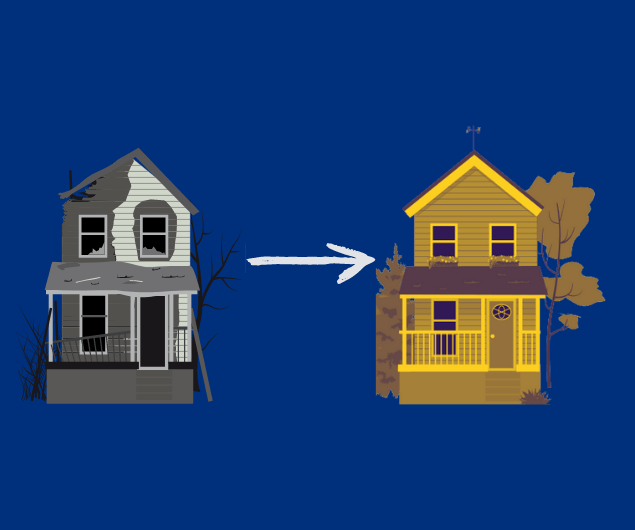Today I am going to share house flipping tax tips for all you renovators out there!
We have talked about this before, but with the latest booming real estate market, I am here to refresh your knowledge!
With approximately 1 million immigrants coming to Canada over the next 3 years, out of which, historically speaking, about 40% come to Ontario. Housing shortages and crazy rental increases are inevitable.
It’s a basic economic principle – supply and demand. High demand and low supply = high price.
The skyrocketing house prices and rise in rental prices can be crazy. They are both fundamentally driven by the number of immigrants coming to Canada and lack of housing supply.
We, Canada, do need these skilled immigrants with education and money to grow our economy.
Fortunately (for people who are already in the market) and unfortunately (for people who don’t have properties yet), we must learn to deal with the rising real estate prices.
For some real estate investors, they may even take advantage of these rising home prices and make some quick profits through house flipping.
Make sure you view my latest video sharing these tips!
Now, let’s dive right in and look at these 6 tax tips you should remember when house flipping …
1. House flipping profits are considered income
Many flippers or renovators are often confused with the tax implication of flipping a house. Many people are under the impression that if you sell a house, only 50% of the profit is taxable.
The misconception often comes in at a huge cost.
If you are truly renovating a property for a quick flip, there was no intention to rent the property out, the profit is considered income. 100% taxable.
If the profit from the flip is $100K, this entire amount is added to your income.
At the highest marginal tax rate in Ontario, round it down at 50%, $50K goes to the government and you are only left with $50K.
If you report the flip incorrectly as capital gain, CRA may even impose a penalty on top of the amount due. This can substantially increase the tax liability.
2. When house flipping, you may have to pay HST on the sale
If you substantially renovate a residential property for resale, or add an addition, you may be required to charge HST when you sell the property.
It is like being a builder selling a new house, you are required to charge HST and remit the amount collected to CRA. You can also claim the HST you paid to contractors and vendors against the amount collected.
Most residential home buyers do not understand the implication of HST. The standard purchase and sale agreement often has a box that says, “purchase price is inclusive of HST”, which leaves the flipper and renovator responsible for HST, should CRA ever come back after you.
If you’re unsure whether you have substantially renovated a home for resale, make sure you consult with a real estate accountant.
3. Paying subcontractors cash without receipts does not qualify as deductions
Contractors love to offer cash deals at a cheaper price to complete the project. As a registered accountant, I can tell you that it’s not worth it.
I have had a few clients who paid cash for a renovation, did not have any receipts and ended up being audited by CRA. There’s nothing in an accountant’s power to defend you when you cannot provide a receipt.
If you choose to take the cash deal and decide not to take the deduction, be aware of the tax cost associated with the decision.
For example, if you pay someone $20,000 cash to do work for you, and you own this flip in the corporation, the cost of not deducting it is $20,000 x 12.2% = $2,440.
On top of the tax loss, you are also exposing yourself to higher amounts of risk. What if the subcontractor isn’t doing what he’s supposed to? Without a proper invoice, how do you properly protect your right?
4. Earning income through corporation would help with tax deferral and legal liability protection
House flipping projects can be big or small.
If it is a big project, proper insurance should be undertaken (instead of a regular home owner insurance).
If it is a big project, you may also be exposed to higher risk. (For those of you who have followed my blog long enough, my mom’s house was under renovation from top to bottom. During the renovation, there was a pipe burst. Insurance eventually covered it, but the story goes to show you that anything can happen!) With any house flip, there comes a bit of a risk.
When you flip a property inside the corporation, it simply provides another layer of protection against your personal assets. A corporation is considered a separate legal entity, which can be used on its own.
Of course, if you are doing flips inside a corporation, profit from flips are considered active business income. Active business income is subject to 12.2% corporation tax in 2022 in Ontario.
If you were to earn the same amount of income in your personal tax, you are liable to pay taxes based on your marginal tax rate, which can be as high as 54%.
5. Moving into the property for a short while to avoid taxes
Some renovators/flippers decide to move into the property to avoid tax liability.
They usually plan to live there for a couple of months, move back to their own home, and sell the property thinking that they can shelter the gain using the primary residence exemption.
To qualify for primary residence exemption, it’s a 2-step process.
First, the property in question must be capital property. There are a bunch of criterias that the CRA looks into when determining whether a property is considered capital property. One of the criteria is intention.
The problem is that intention is subjective, how do you prove that your intention is to truly move into the property?
Some other criteria also include whether the transactions form a part of your regular business, frequency of transactions, etc.
If your true intention is to flip, chances are, you would not even pass the first test.
Of course, if your true intention is to build a home for your own use, that’s a different story.
Then, you are most likely eligible to use primary residence exemption to shelter all the capital gain.
6. Common tax deductions you can make as a flipper
Last but not least, I would like to share with you these 7 common deductions a house flipper should not miss.
- Acquisition costs, legal costs and any other closing costs
Be sure not to miss out on all the deductions such as legal costs, land transfer tax, title insurance and any other closing costs. You should already be aware of what closing costs are typically like in your area since these costs tend to vary from area to area.
To pick up these expenses, you would have to review the trust ledger. - Carrying cost of the property
This includes property taxes, insurance, mortgage interest, hydro, any utilities, lawn care, etc. Be sure to keep track of these expenses so you can deduct them against your profit. - Material cost, labor and contractor’s fees
Generally speaking, you are allowed to deduct expenses you incur for the purpose of generating income.
Direct material cost, labour and contractor you use are expenses that you can link directly to generate the income. Hence these are all deductible expenses. For example, if you remodel the bathroom with new plumbing, frameless shower doors, new tiles and a new toilet, those items and the work done to put them all into place are expenses that are tax deductible.
Be sure to keep a diligent record of the expenses, make sure they do not fade over time (Home Depot receipts simply fade after 2 years). - Automobile expenses
When you drive your car to the site to do the work, inspect the work, pick up materials, expenses incurred on the vehicle are deductible against the income.
You are required to keep a diligent record of the mileage you incur to do the work. - Home office expenses
Many flippers or renovators do not have a proper office space to handle the day to day.
They often use a portion of their home to manage their business.
In that case, you may qualify to claim a portion of your home office expense against the profit to reduce the tax liability. - Advertising
Advertising expenses are the same as direct material costs. Any expenses you incur to assist in selling the property are considered deductible.
This includes staging cost, cleaning expenses (renovation = mess), printing signs and flyers, advertising costs on local newspapers, kijiji, etc. - Closing cost such as realtor commission fees and legal cost
Closing costs such as realtor commission, legal cost and mortgage termination charge are all deductible against the sale of the property.
Be sure to keep track of the expenses to maximize your deduction.
For more advice on flipping houses, feel free to book a consultation with us – your professional tax advisor.
Every situation is unique and tax implications flipping a property may not be the same for everyone.
Until next time, happy Canadian Real Estate Flipping!
Cherry Chan, CPA, CA
Your Real Estate Accountant





